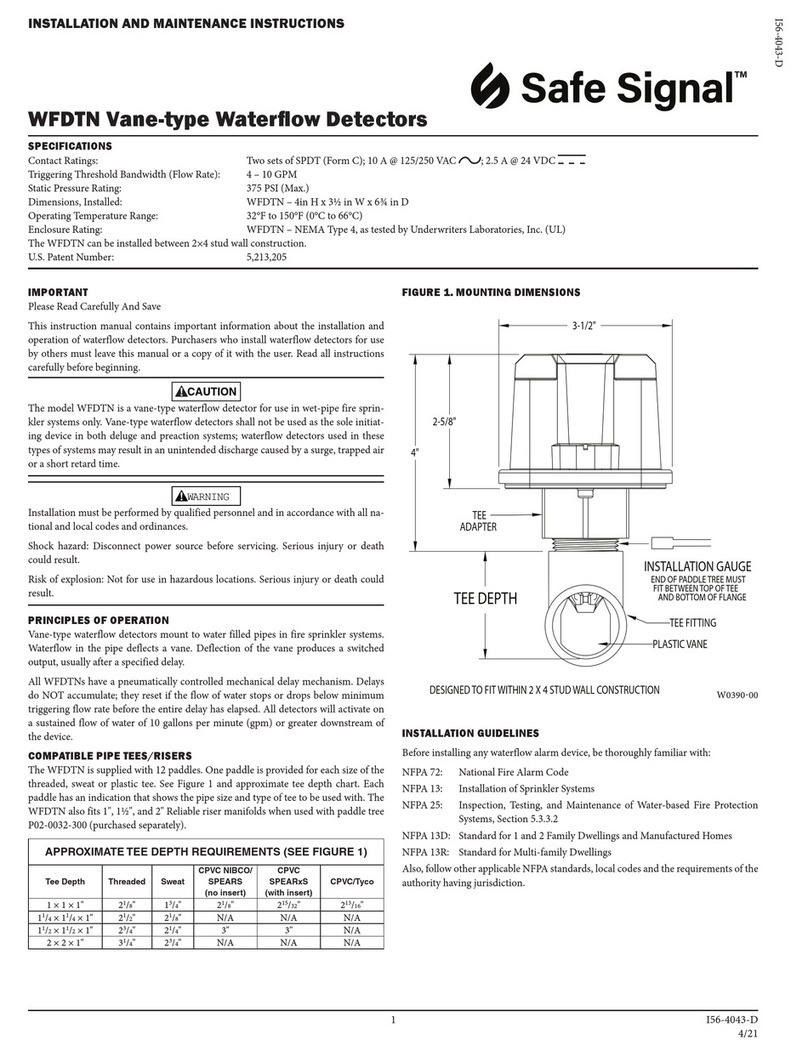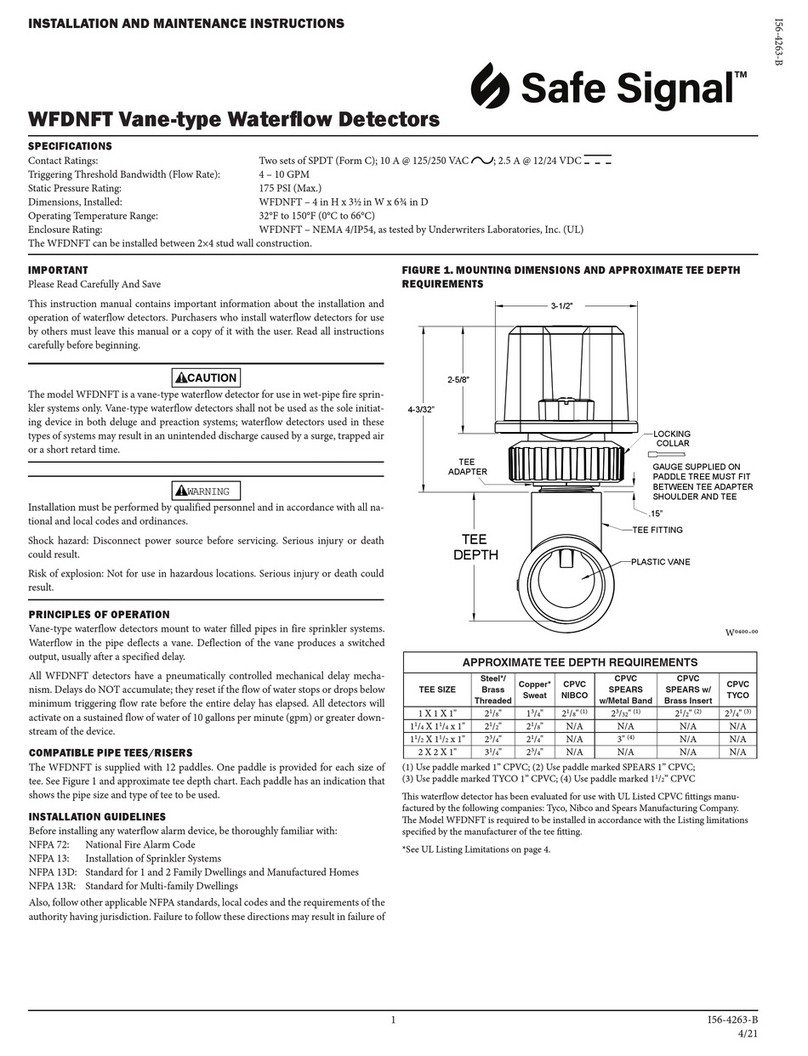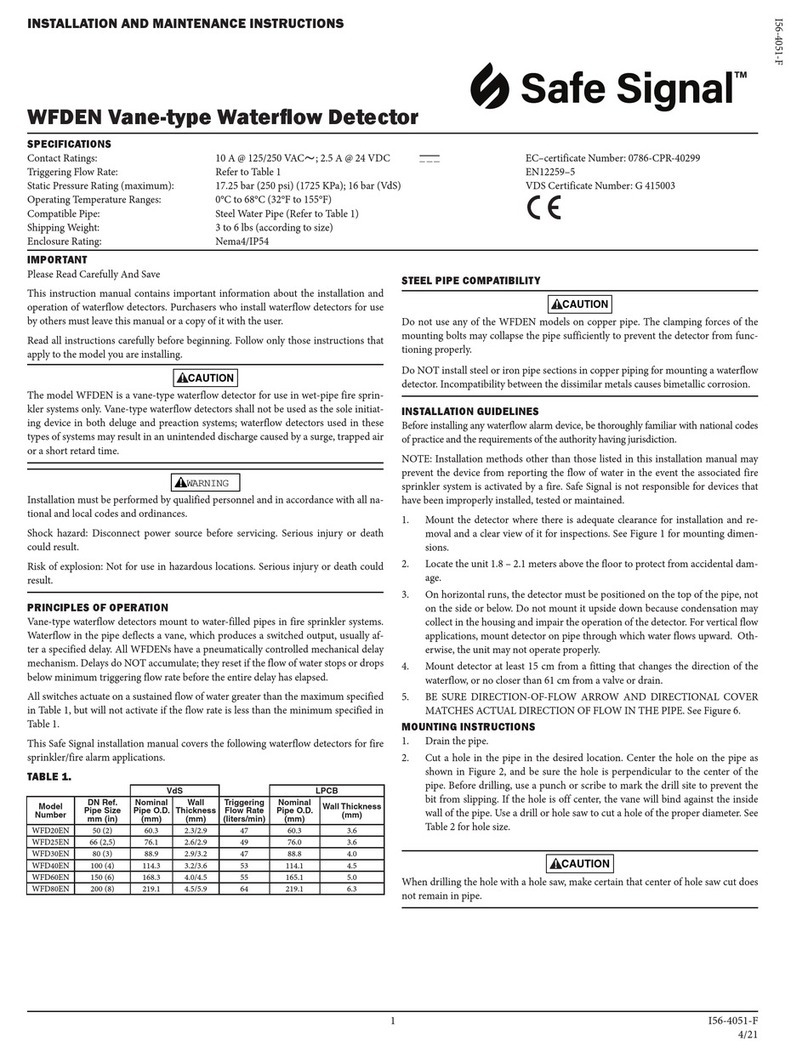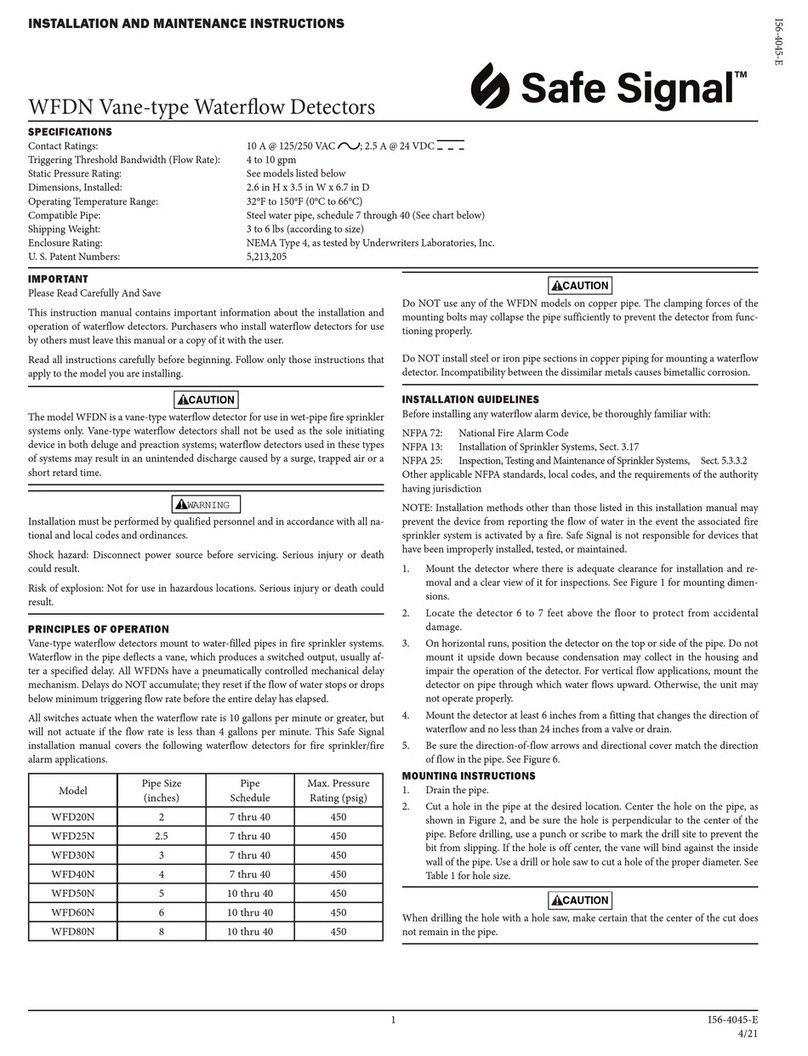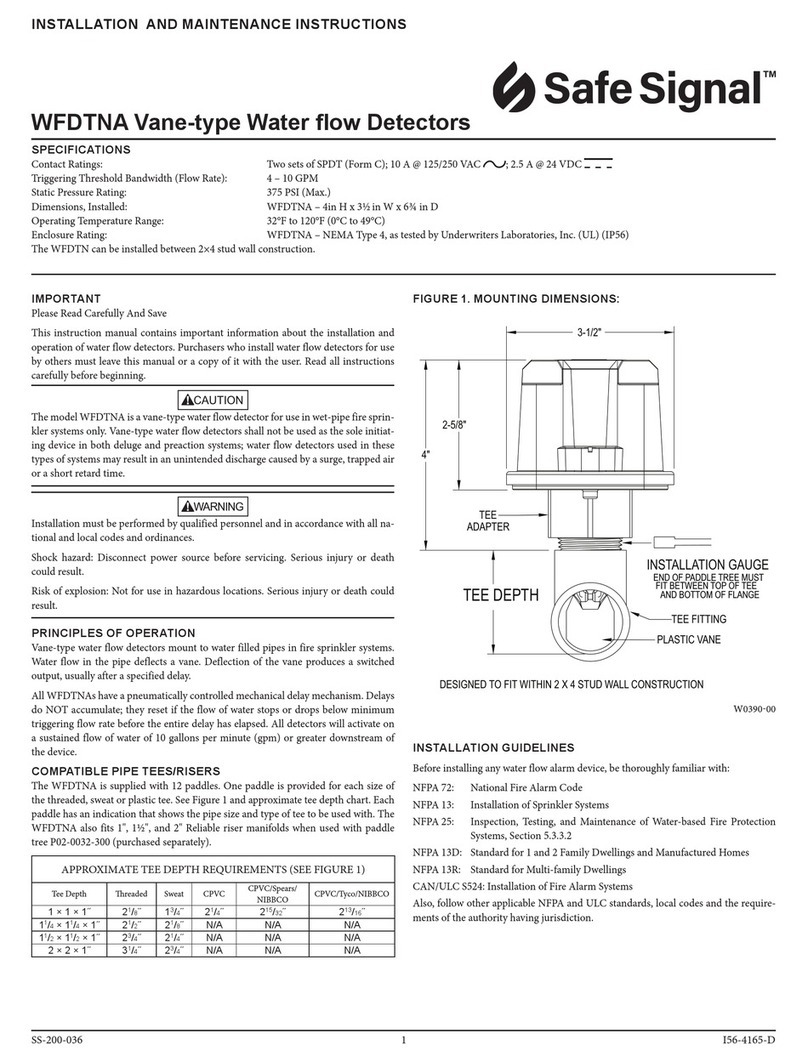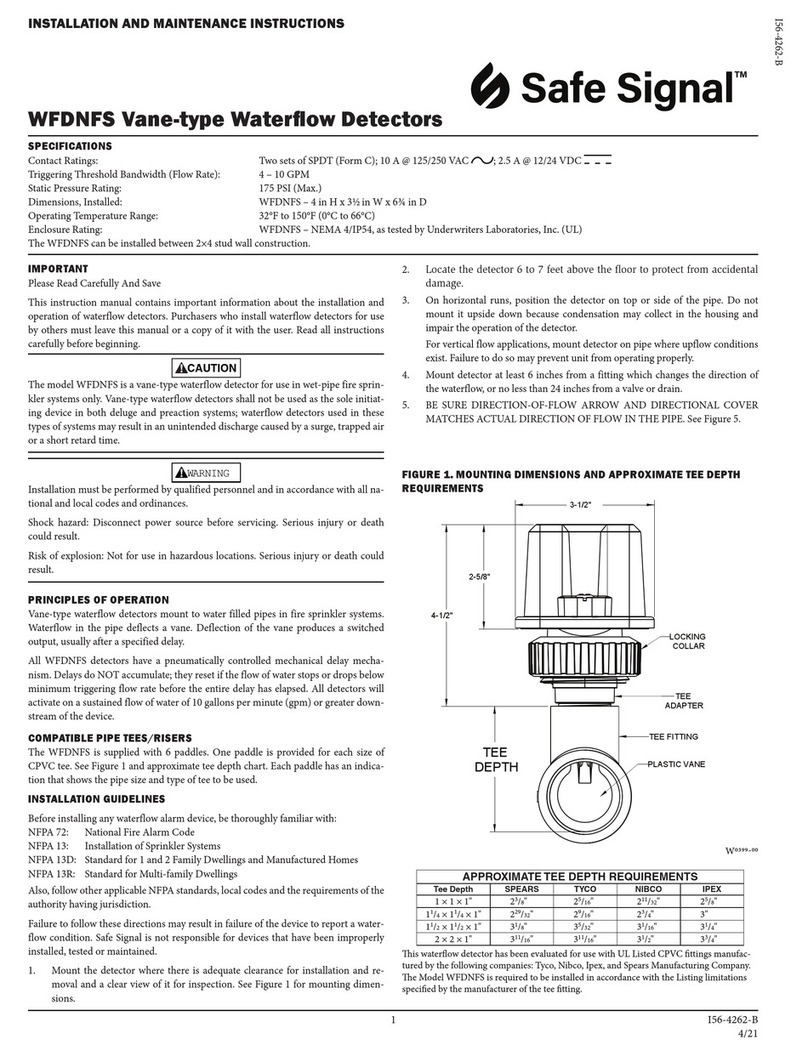
Other applicable NFPA standards, local codes and the requirements of the authority
having jurisdiction.
Failure to follow these directions may result in failure of the device to report a water-
flow condition. Safe Signal is not responsible for devices that have been improperly
installed, tested or maintained.
1. Mount the detector where there is adequate clearance for installation and removal and a
clear view of it for inspection. See Figure 1 for mounting dimensions.
2. Locate the detector 6 to 7 feet above the floor to protect from accidental damage.
3. On horizontal runs, position the detector on top or side of the pipe. Do not
mount it upside down.
4. Mount detector at least 6 inches from a fitting which changes the direction of
the waterflow, or no less than 24 inches from a valve or drain.
5. BE SURE DIRECTION-OF-FLOW ARROW AND DIRECTIONAL COVER
MATCHES ACTUAL DIRECTION OF FLOW IN THE PIPE. See Figure 3.
MOUNTING INSTRUCTIONS
1. This WFDTNRN waterflow detector is designed to fit only the appropriate tee
fitting.
NOTE: The outlet branch of tee must have a 1-inch NPT thread. Do not use a
reducer to achieve the correct thread size. Failure to follow this instruction will
result in failure of the detector to report a waterflow condition.
2. WFDT units are shipped without the paddles mounted to the actuator. Select the
correct size paddle for the tee being used the appropriate nominal pipe diam-
eter size is molded on the surface of the paddles. Align hole on stem of paddle
with hole on actuator lever. Fasten together using a #4-40 x 3/8-inch fillister head
screw supplied in bag assembly. See Figure 2. Use only the screw provided with
the WFDTNRN. Drive screw head through hole in paddle until it seats firmly
to actuator lever surface. No washer is required. For paddle replacement refer to
Maintenance section.
3. Thread detector onto tee fitting and tighten with wrench. Use of thread seal-
ant or tape is recommended. Use height gage (located at end of paddle tree) to
ensure proper depth of detector on tee fitting. See Figure 1. Height gage must fit
between top of tee fitting and under side of hex tee adapter. A gap between gage
and tee adapter is acceptable. When correctly installed, the detector must face
in the proper direction of waterflow and be aligned with the pipe, the provided
directional cover illustrates flow direction for device.
4. Remove the plastic cover with the tamper proof wrench provided. Move the ac-
tuator lever back and forth to check for binding. If the vane binds, remove the
detector and correct the problem before proceeding.
Be sure the direction-of-flow arrow and directional cover points in the correct direc-
tion, otherwise a waterflow condition will go unreported. See Figure 3.
FIGURE 3. DIRECTIONAL COVER
OPERATIONAL TESTING
Always notify a central station monitoring waterflow alarms before repairing, main-
taining, or testing waterflow alarm devices.
1. Fill the fire sprinkler system and check for leaks around the WFDTNRN. If it
leaks, check to see that the fittings are tight. If leak persists, drain the system and
remove the detector (see removal instructions under Maintenance). Check for
damaged threads or cracked fitting. Reinstall detector and check again for leaks.
Do not proceed until all leaks have been stopped.
2. With cover removed, connect an ohmmeter or continuity tester across (COM and
B-NO) terminal switch contacts. The ohmmeter should show an open circuit, no
continuity (when the red switch buttons are depressed).
3. Deflect the actuator lever to release the switch buttons. The ohmmeter or conti-
nuity tester should show a short circuit when the switch buttons are released.
4. Open the inspector’s test valve to allow the detector to indicate a flow condition.
The detector should remain activated until the inspector’s test valve is closed.
Air pockets in the sprinkler system may prevent the detector from firing im-
mediately.
5. Replace the cover and tighten the security screws with the tamper proof wrench.
Store wrench is a secure place.
FIELD WIRING
1. The WFDTNRN has two SPDT switches. Switch contacts (COM and B-NO) are
closed when water is flowing and open when water is not flowing. Connect the
switches as shown in Figure 4 depending on the application.
2. When connected to a listed sprinkler/fire alarm control panel, the initiating cir-
cuit must be be unable to be silenced.
3. A ground screw is provided with all WFDTNRN units. When grounding is re-
quired, clamp wire with screw in hole located between conduit entrance holes.
See Figure 5.
4. Use proper waterproof conduit fittings where required.
High Voltage. Electrocution Hazard. Do not handle live AC wiring or work on a device to
which AC power is applied. Doing so may result in severe injury or death.
When utilizing switches at voltages greater than 74VDC or 49VAC means
to provide all–pole disconnection must be incorporated in the field wiring, such as a
circuit breaker.
NOTCHED COVER INDICATES FLOW DIRECTION AT A
DISTANCE FROM MULTIPLE VIEWING ANGLES
W038200
2 I56-4044-E
4/21






